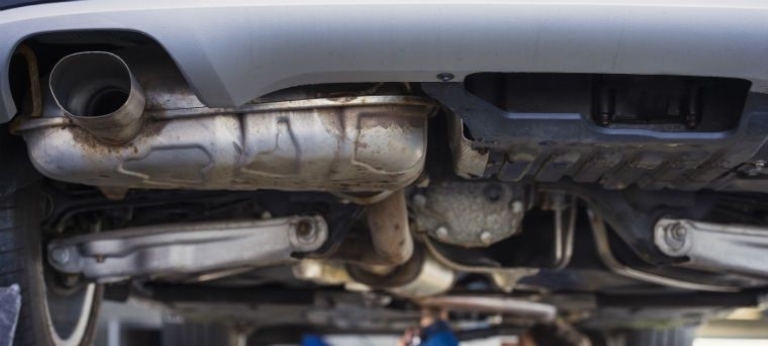Contents
Utes and big 4WDs are some of the most modded cars Down Under. They’re also the best-selling vehicle category. With this in mind, there’s a huge range of original equipment and aftermarket accessories to customise any vehicle. If you’re intent on longer Outback trips (or the Big Lap) a fully optioned and packed 4WD with all the necessities will get you there. Parts like uprated suspension for better articulation, off-roading tyres for more bite, and a fully appointed exhaust for better airflow are goodies that will get you mile-crunching fun in the red soils.
Why Upgrade Your Factory Patrol Exhaust System?

So what’s wrong with stock systems fitted to current and previous Patrol generations? While off-roading enthusiasts are eager for the next model, factory exhausts are the cost-cutting component that doesn’t do the big V8 petrol or previous diesel engines any favours. The tubing isn’t wide enough to handle the volume of spent gases, and winds through nooks and crannies, creating unwanted restrictions. This has a knock-on effect, producing backpressure, with the risk of exhaust gases returning in the combustion chamber or lingering too long in the piping. And this is what kills power.
If you’re heading off-road, then durability can also be an issue. Factory exhausts are made using thinner gauge mild steel that can be adequate for the tarmac, but the thin walls can dent or rupture when scraping rocks and stumps, or corrode in river crossings. And for older Patrols, ditching outdated DPF filters can significantly reduce emissions and fuel use. Mind, the petrol versions also include the same filtering tech with revised catalytic converters that also increase airflow for higher efficiency,
Lastly, look for aftermarket Nissan Patrol exhausts if you’re concerned about sound and looks. Aftermarket systems are better finished, some with chromed or tips in exotic materials, and the piping features muffler and resonator configurations that get the best sound out of the big engines. Owners of older 4WDs (the GQ/GU and Y60/61 badged cars) can additionally quieten things down with “quiet’ mufflers to tame excessive noise.
Benefits of Aftermarket Systems
Now that you know what you’re missing, let’s list everything you get for a couple of hundred dollars when going with a well-built aftermarket unit. The wider, straighter piping helps engines produce more power and torque with improved combustion efficiency. How much more power you get depends on how much of the old exhaust you get rid of. Full systems, from the manifold to the tips, can muster over 10 per cent additional grunt, with power and torque spread over a wider power band. Good for technical trails, or hauling a trailer or caravan over unpaved roads.
Next, there’s substantially better durability with improved production methods (mandrel bending and heat treatment) and stronger and more resistant stainless steel in thicker gauges—something you’ll need in the Outback. The designs are also easier on the engine, producing less heat and pressure, so you’ll also be saving by avoiding unnecessary repairs when pushing the Patrol too hard. Parts that usually suffer under the factory exhaust hammer (exhaust valves, cams, and internals) can cost thousands to repair, and this is money you can put towards your next off-roading adventure or don the Patrol with needed accessories such as a fully-featured bull bar and winch. And with better fuel use, you can take your 4WD further before filling up.
Choosing What’s Right
Figure out what you want from any addition to your 4WD before purchasing. Exhausts come in different configurations, using varied designs and parts in sections of the piping for different ends. If you’re more about power, then a full header-back system for the petrol engines or a turbo-back exhaust for diesels is a no-compromise option bringing the best of everything. The higher cost goes to revised extractor pipes, wider collectors, and straighter and stronger piping throughout. Some can also have high-flow cats or more efficient particle filters to reduce emissions, tame the sound, and cut down on fuel. All parts fit in the factory recesses, and the modular bolt-on designs make for quick and easy installation. For reduced vibrations and noise, also look for quality mounting hardware in the same high-grade metal.
Cat-back and DPF-back Nissan Patrol exhausts change the factory tubing about halfway (from the converter and filter), with wider mid-section piping bringing some of the power benefits of full systems. They’re often the popular choice, delivering balanced power and durability benefits. If you’re more about the sound coming from the tips, then cheaper axle-back systems, with new parts from the rear axle, are the way to go. These can have varied mufflers (straight-tube or quiet) and include resonators to deal with exhaust droning for more peace. If it were my money, there’s more fun with straight tubes, as they reveal more of the sound produced by all cylinders.
Finally, consider brands, materials and fit. Local exhaust makers use high-tech equipment to temper and form stainless steel to the right dimensions and ensure uniformity. Of course, you can also choose titanium, Inconel or carbon fibre for even more strength when dealing with temperatures over 700 degrees, lower weight, and more off-roading flexibility. Lastly, ensure what you’re getting is exactly for your Patrol. Exhaust parts, sizes and shapes differ for different badges and MY, so choose parts with your VIN for a snug fit.

